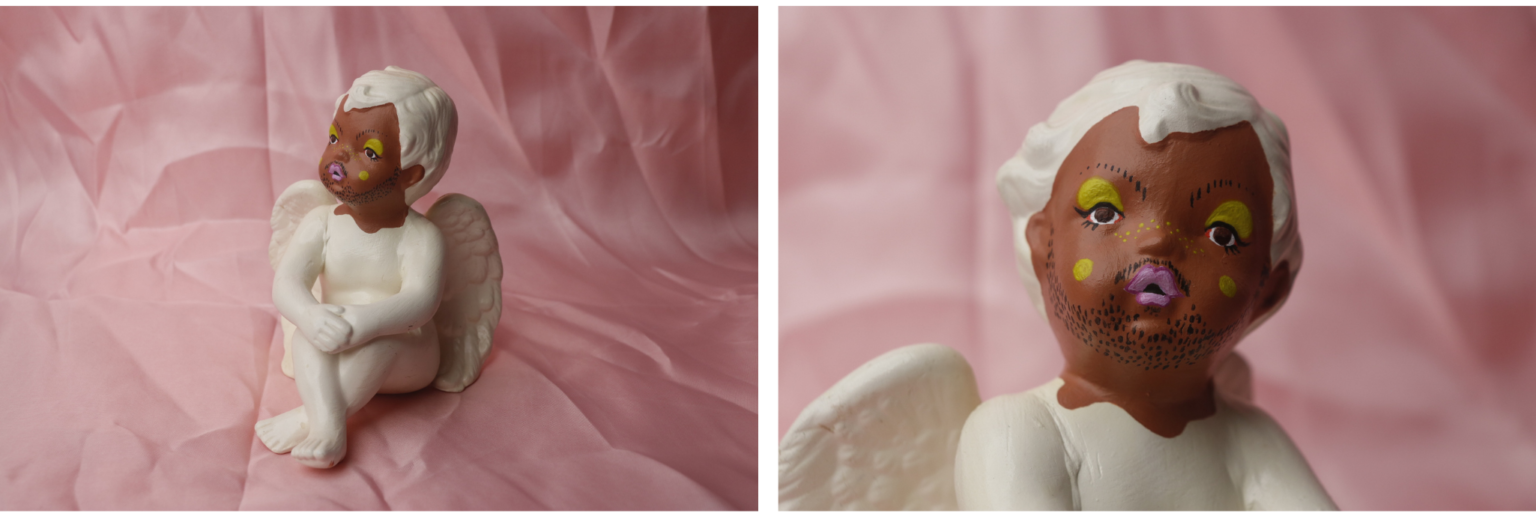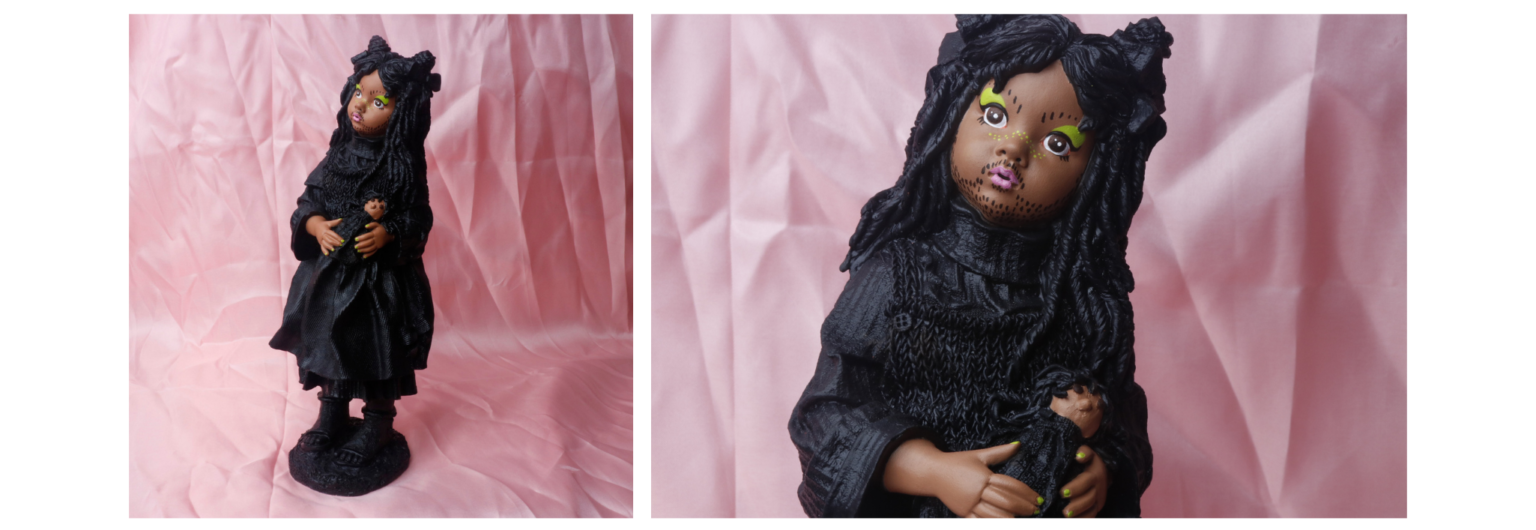Via the Orange County Arts Commission, Article by Emilie Menzel
You’ve surely seen those kitsch ceramic figurines before—above your grandmother’s fireplace, in a Hallmark aisle, or in the corner of a thrift store. You can find them in truly any antique store in America. The characters are cherubic in their plump cheeks, pout lips, and wide eyes. Frequently the statuettes depict a pair of siblings, two lovers, or a tiny family acting out scenes of pure, universal emotions: this is friendship, this is mother’s love, this is hope. Chapel Hill visual artist Charlie Dupee describes the objects as both “really horrible…overly-stylized people” and “wonderful,” and he has placed them at the center of his current creative project.

Left to Right: Charlie Dupee in “The Vanity Project No. 997,” “The Vanity Project No. 1171,” and “The Vanity Project No. 1264” (photos by Tristan Brown, styling by Matthew Wheatley)
As a child, Charlie would regularly give his mother figurines like this for Mothers’ Day and Christmas, “really any kind of excuse,” he says, “I would give her one of these figurines.” The gifts were tokens of affection: look at how these two in the figurine love one another, think of how much I love you. It’s only recently that Charlie has begun to rethink his love of these strange, campy objects. As a Black child, what did gifting these caricatures actually mean?
The ceramic figurines are designed as so-called universal representations of emotions and people, and yet there’s a critical oversight in this plan: the figurines are nearly always painted as porcelain white and blond-haired. On the rare occasion that these figurines do depict Black persons, the caricatures veer into blackface and reproduce harmful stereotypes like The Mammy and Uncle Tom. So much for representing everyone.
“I started thinking about different forms of representation, and forms of representation we really take for granted every day,” explains Charlie. “I would be giving [my mother] these things, and that if there are two figures, I’d be like ‘oh that’s you and me,’ even though the figures did not look like me. So it really got me to think about who decided this kind of aesthetic, this Euro-centric representation of a person is a universal representation.” For Charlie’s current project, he’s repainting these figurines in his own image. “I think it’s an act of radical self-love in a way,” says Charlie, and there’s really something quite tender about the project. Charlie’s approach to the figurines is startlingly careful and deeply personal. The repainted figurines are very much Charlie—his warm skin, his particular shade of magenta lipstick, the precisely replicated stubble, spots of delicate yellow eyeshadow speckling the nose. These repainted figurines depict a precise individual, painted with detail, not an archetype as the original figurines embody. Charlie’s repainted figurines find a way to overlay the specific onto the mass produced, to communicate both a deep affection for the kitsch figurine form and the powerful need to be seen. Repainting the objects brings a flush of humanity to these caricatures, “a layer of vulnerability and complexity to these mass produced works of representation,” as Charlie describes it.

Charlie Dupee’s repainted ceramic figurines
To return to these figurines’ classification as kitsch, there’s something quite fitting about this descriptor as relates to Charlie’s project. Kitsch: as in gaudy and garish and in poor taste. Kitsch: as in overly sentimental, overly stylized, overly overly. Kitsch is really rather fluidly defined in opposition to the master aesthetic. Kitsch is, well, not that.
In a way, Charlie’s delicate repainting of the thrifted ceramic figurines, then, is a full embrace of these objects’ kitsch character. Let them grate against the grain. What is more kitsch than amping up an art object’s contrast to the master definition of beauty, i.e. white skin? There’s that famous John Waters quote: “To understand bad taste one must have very good taste.” I’d like to venture that that applies here.
Charlie Dupee is a visual artist and Maine native. His work approaches topics of intersectionality, untold history, and futurism in reaction to systems of white supremacy, heteronormativity, and capitalism. His formal background in painting and photography help develop a multidisciplinary vocabulary of queer, American, kitsch, nonsense. He is currently an MFA candidate in Art and Art History at UNC Chapel Hill. Follow Charlie at @charliedupeee on Instagram.

Charlie Dupee’s repainted ceramic figurines
 Chapelboro.com has partnered with the Orange County Arts Commission to bring more arts-focused content to our readers through columns written by local people about some of the fantastic things happening in our local arts scene! Since 1985, the OCAC has worked to to promote and strengthen the artistic and cultural development of Orange County, North Carolina.
Chapelboro.com has partnered with the Orange County Arts Commission to bring more arts-focused content to our readers through columns written by local people about some of the fantastic things happening in our local arts scene! Since 1985, the OCAC has worked to to promote and strengthen the artistic and cultural development of Orange County, North Carolina.


